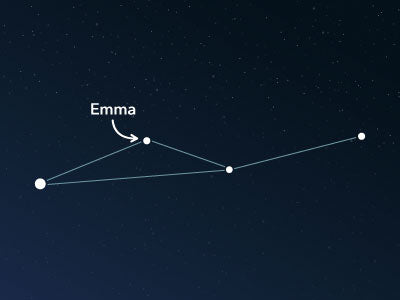The constellation Leo Minor
Caractéristiques
- Nom latin
- Leo Minor
- Hémisphère
- Hémisphère nord
- Visibilité
- All year round
- Région
- 232 deg²
- Étoile la plus brillante
- Praecipua (HIP number 53229)
- Spécialités
- Galaxies

The Leo Minor, commonly known as Lesser Lion or Little Lion, is a small and inconspicuous constellation in the northern sky. It was introduced in the 16th century and contains only a few deep-sky objects to observe.
Hemisphere, visibility, and area
The Leo Minor constellation is located in the northern hemisphere. Due to its location, it is visible from many places. It can be seen from everywhere north of the equator. In the south, it is visible up to the 49th parallel. Therefore, it can also be observed from many regions there. Only in latitudes such as the southern areas of Patagonia to Antarctica is it not visible.
In latitudes like Central Europe or Canada, Leo Minor is circumpolar, meaning it is visible throughout the year. Between the end of March and the beginning of June, it is particularly high in the sky. This season is, therefore, also the best time to observe the constellation for more southern regions.
It has an area of about 232 square degrees, making it the 64th largest constellation compared to all 88 constellations.
In most visualizations, the four main stars are connected to each other. Three form a triangle, while a fourth star is an extension at one corner. The triangle represents the hindquarters and tail of Leo Minor, while the fourth star leads to the head.
The brightest star in Leo Minor is named Praecipua or 46 Leonis Minoris. It has a mere apparent magnitude of about 3.8 and is not particularly noticeable.
The inconspicuous stars make finding Leo Minor in the night sky challenging. Therefore, it can be helpful to look for the adjacent constellations. To the north is the well-known Ursa Major, and to the east is Lynx. Additionally, the astrological constellation Cancer juts in the east. With Leo in the south, another constellation of the ecliptic borders on Leo Minor.
Specialties in the constellation
Because the star constellation is located away from the Milky Way, it does not have many objects, such as open star clusters or dark clouds. However, this comparable darkness offers a good view of faint galaxies. But larger telescopes are required for this purpose.
NGC 2859 is one of the brightest galaxies in Leo Minor. It was discovered by the German-British astronomer William Herschel in March 1786. Its distance from the Milky Way is estimated to be around 74 million years. It appears as a diffuse yellow nebula on astronomical photographs and can be found immediately on the border with the neighboring Lynx constellation.
At the same time, William Herschel also discovered the spiral galaxy NGC 3254. Its distance from the Milky Way is approximately 59 million light-years.

Several other galaxies in the area of Leo Minor can be observed with professional equipment.
History
The origin of the constellation Leo Minor does not come from Greek mythology, and its historical background is not particularly exciting.
It is only known that the polish astronomer Johannes Hevelius introduced Leo Minor in 1687. Presumably, he only filled the undefined area between the two known constellations of the Ursa Major and the Lion.
PubliéLire d'autres articles intéressants

An overview of all 88 constellations
Learn more about all 88 constellations and read interesting information about the mythology, visibility, and features.

Application Planétarium
Découvrez le ciel nocturne avec notre application de planétarium !
Disponible pour iOS et Android.

Nommez une étoile dans la constellation Lesser Lion, Little Lion
Name a star in a constellation and create something that lasts for eternity.